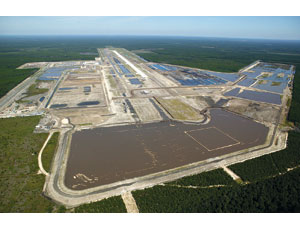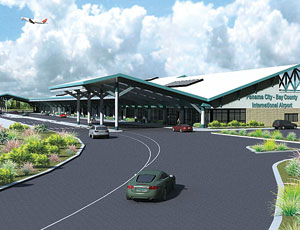It’s been a turbulent ride, but developers and builders of the nation’s first major greenfield airport to be built since Denver’s in 1995 are gearing up for a final landing in Panama Bay County, Fla. Lawsuits and an ongoing contractor dispute notwithstanding, officials with the Panama City-Bay County Airport Authority still plan on a May completion of the $330-million airport, envisioned as a crucial spur for future economic growth in Florida’s panhandle.


The 4,000-acre airport site, donated by developer St. Joe Co., Jacksonville, is a launching pad for an ambitious long-range master plan for a 74,000-acre development in northwest Florida. A nearby existing airport has just one 6,000-ft-long runway and nowhere to grow because of its proximity to environmentally sensitive West Bay and two military airfields.
The project broke ground in late 2007 with the clearing of 1,330 acres. Phoenix Construction, Lynn Haven, Fla., won a $112.5-million contract for site preparation and runway paving. Within three months, 6 million cu yd earth was moved, with “1 million cu yd of that being muck,” says Jeff Dealy, program manager with KBR, Houston, the construction and program manager. Crews disposed of the muck on-site in a pit, reusing the excavated good earth.
The new airport sits amid 41,000 acres that are set aside “forever” as undevelopable wetlands, says Jerry Ray, senior vice president for external affairs with St. Joe Co. That means crews can work without noise issues, and the new 8,400-ft-long main runway “is aligned so that it can run 24/7 forever.”
Along with a secondary 5,000-ft-long partner, the major runway is nearing completion. Officials are waiting for federal approval to begin a 1,600-ft-long extension that will take the main runway to 10,000 ft, says Dealy.
Walbridge, Detroit, also is nearing completion on a $58-million contract to build a 125,000-sq-ft, seven-gate terminal building and support facilities, including the control tower, a cargo and maintenance building, a two-story public-safety building and a utility building. In late 2008, with soaring materials costs, “it was the worst time for bids,” says Randy Curtis, airport executive director. Walbridge’s low bid came in at $68 million.
That led to intensive value-engineering efforts with Walbridge, KBR and lead designer HNTB Corp., Kansas City. Designers scaled back the size of the steel canopy roof, and a timely Transportation Security Administration grant of $4 million for the baggage handling system helped recoup $10 million.
The new, 500-ft-long terminal will serve as one of four TSA test-bed sites for new security technology. Researchers with the Panama City branch of the Naval Surface Warfare Center will install components of advanced perimeter security measures at the new terminal, says Michael J. Adams, program analyst. TSA officials will evaluate and test the technology to determine future deployment.
Despite dozens of public meetings and the input of local environmental groups, officials also had to deal with challenges to its Federal Aviation Administration environmental impact statement and its U.S. Army Corps of Engineers permit. After two months in court, the airport won the legal battle in February 2008.
Some turbulence still exists. The state Dept. of Environmental Protection levied a $1.7-million penalty against Phoenix for failure to comply with a stormwater protection plan because planted grasses are not growing properly. DEP also fined the airport $251,000 for stormwater violations—for which the airport wants Phoenix to pay, says Dealy. Phoenix plans to contest the fines.









Post a comment to this article
Report Abusive Comment